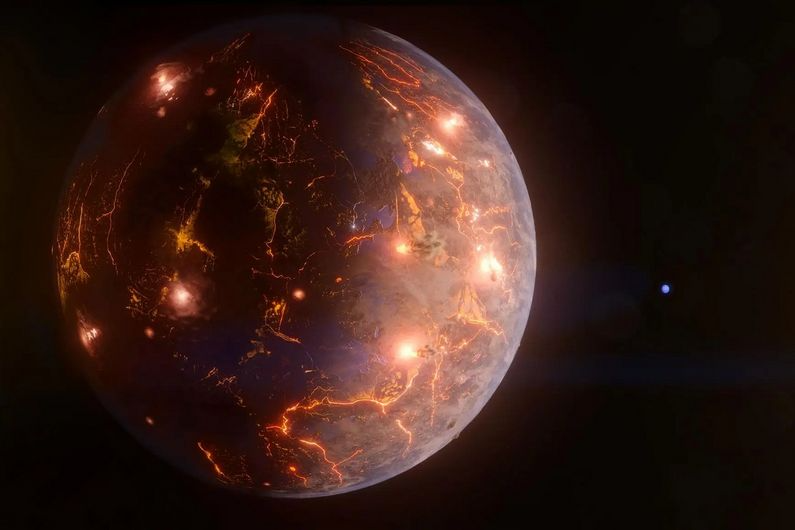Found: a Likely Volcano-Covered Terrestrial World Outside the Solar System
A large international team led by astronomers at the Trottier Institute for Research on Exoplanets at Université de Montréal (UdeM) today announced in the journal Nature the discovery of a new temperate world around a nearby small star.
 Astronomers from Université de Montréal have discovered an Earth-sized exoplanet around a nearby small red dwarf star that appears to be carpeted with volcanoes.
Astronomers from Université de Montréal have discovered an Earth-sized exoplanet around a nearby small red dwarf star that appears to be carpeted with volcanoes.
A large international team led by astronomers at the Trottier Institute for Research on Exoplanets at Université de Montréal (UdeM) today announced in the journal Nature the discovery of a new temperate world around a nearby small star.
 This planet, named LP 791-18 d, has a radius and a mass consistent with those of Earth. Observations of this exoplanet and another one in the same system indicate that LP 791-18 d is likely covered with volcanoes similar to Jupiter’s moon Io, the most volcanically active body in our Solar System.
This planet, named LP 791-18 d, has a radius and a mass consistent with those of Earth. Observations of this exoplanet and another one in the same system indicate that LP 791-18 d is likely covered with volcanoes similar to Jupiter’s moon Io, the most volcanically active body in our Solar System.
“The discovery of this exoplanet is an extraordinary find,“ said Professor Björn Benneke from UdeM’s Department of Physics. “The similarity in the properties of LP 791-18 d and Earth as well as the prospect of detectable geological activity and volcanism on it make it a key object to better understand how terrestrial worlds form and evolve.”
Thanks to the very small size of the star – which is only slightly bigger than planet Jupiter – it should be possible to detect the atmosphere of this exoplanet, if it has one, using the James Webb Space Telescope.
A new terrestrial world in a multi-planetary system
The planet discovery was led by Merrin Peterson, a graduate student in Benneke’s team at the Trottier Institute. It was found and studied using data from NASA’s Spitzer Space Telescope and Transiting Exoplanet Survey Satellite (TESS), as well as a suite of ground-based observatories all over the world.
LP 791-18 d orbits a small red dwarf star about 86 light-years away in the southern constellation Crater. The Spitzer Telescope saw the star’s infrared light dim slightly when the planet passed in front of its disc a phenomenon called a transit. The observations of the system in October 2019 were among the last Spitzer collected before it was decommissioned.
Benneke’s team used the data to determine that the planet is virtually the same size as Earth. With an orbital period of only 2.8 days, the exoplanet LP 791-18 d is located very close to its host star. However, the star is much smaller and less bright than our Sun. The temperature on LP-791-18 d is thus only slightly higher than on Earth.
Astronomers have known about two other worlds in this system, planets LP 791-18 b and c, since 2019, when they were detected by the TESS satellite. Planet b is about 20% bigger than Earth and circles its star in a little less than a day, while Planet c is about 2.5 times Earth’s size and has a period of about 5 days. The newly found exoplanet d is thus the smallest in the family and orbits between planets b and c at an intermediate distance from the star.
Intense volcanic activity
 By precisely tracking the movement of the planet, the team realised that planets c and d pass very close to each other as they trace their orbits. At their closest, they are only 1.5 million kilometres apart, which is 33 times closer than Mars and Earth ever get to each other. Each close passage between the planets produces a gravitational tug on planet d, making its orbit less circular and more elliptical. Along this elliptical path, planet d is slightly deformed every time it goes around the star. The astronomers computed that this deformation produces a lot of heat in the interior of the planet that needs to be transported to the surface via intense volcanic activity. Due to this phenomenon called tidal heating, LP 791-18 d is likely carpeted with volcanoes.
By precisely tracking the movement of the planet, the team realised that planets c and d pass very close to each other as they trace their orbits. At their closest, they are only 1.5 million kilometres apart, which is 33 times closer than Mars and Earth ever get to each other. Each close passage between the planets produces a gravitational tug on planet d, making its orbit less circular and more elliptical. Along this elliptical path, planet d is slightly deformed every time it goes around the star. The astronomers computed that this deformation produces a lot of heat in the interior of the planet that needs to be transported to the surface via intense volcanic activity. Due to this phenomenon called tidal heating, LP 791-18 d is likely carpeted with volcanoes.
"The significant friction generated by tidal heating in the planet is responsible for heating its interior to a considerable extent, ultimately enabling the existence of a subsurface magma ocean," explained Caroline Piaulet, an UdeM Ph.D. student who was involved in the discovery. "In our Solar System, we know that Jupiter's moon Io is affected by Jupiter and its other moons in a similar way, and that world is the most volcanic we know."
Planet d sits on the inner edge of the temperate (or "habitable") zone, the traditional range of distances from a star where scientists hypothesise liquid water could exist on a planet’s surface. If the planet is as geologically active as UdeM’s team suspects, it could maintain an atmosphere. Given the right conditions, temperatures could even drop low enough on the planet’s night side for water to condense on the surface.
Measuring the masses of the planets
The proximity of Planets c and d also helped scientists measure their masses. When approached by Benneke with this discovery, many members of the TESS Follow-up Observing Program turned their ground-based telescopes to the LP 791-18 system, allowing them to collect observations of 67 transits from Planets c and d.
In these data, the team at UdeM was able to detect transit timing variations, which are slight differences in the exact times of the planets’ transits caused by the gravitational tug they exert on each other.
"This technique allowed us to estimate the masses of Planets c and d using only the transit data," Piaulet explained. "By combining this information with the size of the planets – an information readily available from the same data – we can estimate the density of the planets and thus get an idea of their composition and nature."
Comparing these values with planet interior models, astronomers were thus able to determine that the newly-found planet has a mass comparable to that of Earth. Its density is thus also consistent with a rocky composition like Earth. Planet c, which has a mass of about 7 times that of Earth's, has probably retained a significant amount of gas or lighter materials, akin to Neptune’s composition.
'Crucial to analyse the atmosphere'
Planet c, the largest of the system, has already been approved for observing time on the Webb Telescope, as part of the Canadian NEAT program, dedicated to the study of exoplanets. Pierre-Alexis Roy, another Ph.D. student on Benneke’s team at UdeM, will be in charge of analysing these observations. "Having a precise constraint on the mass of Planet c will be crucial to analyse the substantial atmosphere we're expecting to find on this mini-Neptune", he explains.
In the future, the small size of the star may even allow the detection of a much less extended atmosphere on the newly found planet d. Scientists expect that an atmosphere like that of the Earth, Venus, or Saturn's moon Titan could exist on Planet d. This system represents an unparalleled opportunity to learn more about small rocky planets, much like the TRAPPIST-1 system, which hosts seven Earth-sized planets, and is already being closely scrutinized by Webb.It is thus a prime target for Webb in the next few years that represents a similar opportunity to the TRAPPIST-1 system, which hosts seven Earth-sized planets.
"This system provides astronomers with a precious laboratory for testing various hypotheses related to the formation and evolution of terrestrial planets,'' said Benneke. "The newly found planet d, an Earth-size world likely covered in volcanoes in a multiplanetary system, provides unprecedented opportunities to advance not only astronomy but many other fields of science, notably geology, planetary sciences, atmospheric sciences, and possibly astrobiology."
Publication: Merrin S. Peterson, et al., A temperate Earth-sized planet with tidal heating transiting an M6 star, Nature (2023). DOI: 10.1038/s41586-023-05934-8.
Original Story Source: University of Montreal

 Alerts Sign-up
Alerts Sign-up